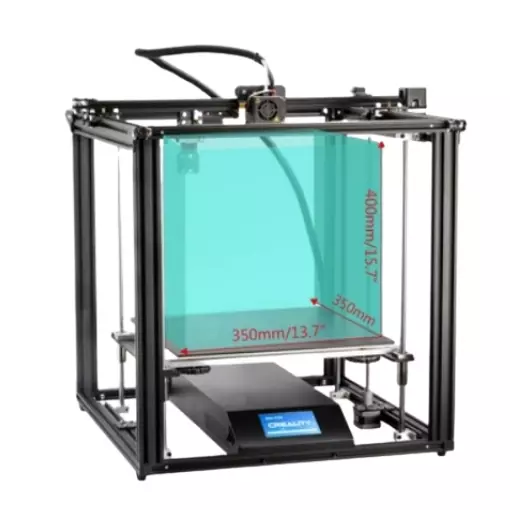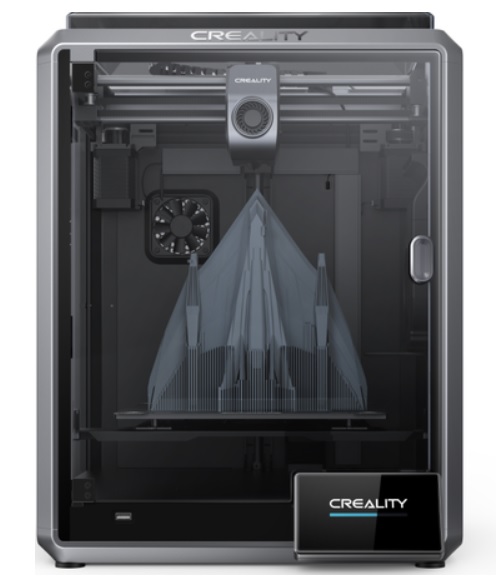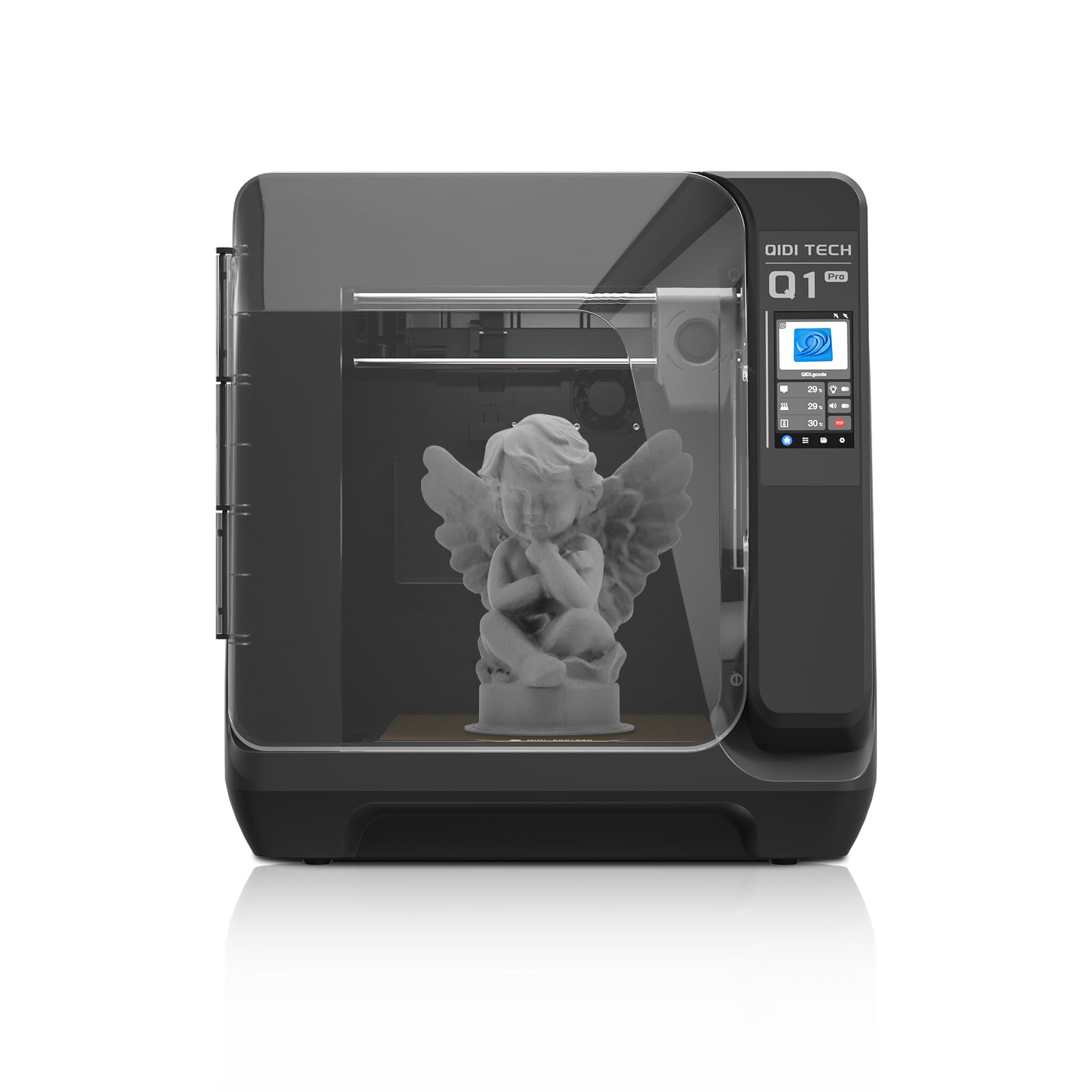Compare Ender 5 Plus vs K1 vs Q1 PRO
Comparison between the best 3D printers
Choose the best 3D printer at the best price. The cheapest 3D printers are here.
Buy a 3D printer here with 3D Fila.
 |
 |
 |
|
| Model | Ender 5 Plus[BUY Ender 5 Plus] |
K1[BUY K1] |
Q1 PRO[BUY Q1 PRO] |
| Printing Material | Filament | Filament | Filament |
| Estimated price | $599,00 | $399,00 | $449,00 |
| Fabricante | Creality 3D | Creality 3D | QIDI |
| Release Year | 2019 | 2023 | 2024 |
| Print Volume [mm] | 350x350x400 | 220x220x250 | 245x245x245 |
| Printer Size [mm] | 632x619x666 | 355x355x480 | 467x477x489 |
| Weight [kg] | 18,2 | 12,5 | 20 |
| Power Loss Recovery | YES | YES | YES |
| Enclosed printer | NO | YES | NO |
| Bed Leveling | Automatic | Automatic | Automatic |
| Filament End Sensor | YES | YES | YES |
| Bed type | Heated | Heated | Heated |
| Power supply system | Bowden | Direct Drive | Direct Drive |
| Standard nozzle | 0,4 | 0,4 | 0,4 |
| Maximum Nozzle Temperature [°C] | 260 | 300 | 350 |
| Maximum Bed Temperature [°C] | 100 | 120 | 120 |
| Maximum printing speed [mm/s] | 180 | 600 | 600 |
| Filament holder | YES | YES | YES |
| Camera for supervision | NO | NO | YES |
| Recommended filaments | PLA, TPU, ABS, PETG | ABS, PLA, PETG, PET, TPU, PA, ABS, ASA, PC, PLA-CF, PA-CF, PET-CF | PLA、ABS、ASA、PETG、TPU、PC、PA、PA-CF、PET-CF、PAHT-CF etc. |
| Recommended slicers | Cura, Simplify, Slic3r | Creality Print; Cura, Simplify3D e PrusaSlicer | QIDI Slicer/Cura/Simplify 3D/ORCA/PRUSA Slicer |
| Maximum Resolution [mm] | 0,1 | 0,1 | 0,1 |
| Processor | 32 bits | Cortex-A53,64-bit Processor | |
| Display | Touchscreen TFT 4,3'' | Display touchscreen 4,3'' | Touchscreen 4,3'' |
| Power Supply | 24V / 504W | 110/220V / 350W | 350 W |
| Connectivity | SD / USB | Ethernet / USB / Wi-Fi | WiFi/USB Flash Drive/Ethernet Cable |
| Operating systems | Windows, Mac, Linux | Windows, Mac, Linux | Windows, Linux, Macbook |
| Date of registration in the system | 2021-04-14 | 2023-04-17 | 2024-07-09 |
| Release date | 2019 | 2023 | 2024 |
| Extra features | The Ender 5 Plus offers a large print volume (350x350x400 mm) and fast assembly. It includes a BLTouch sensor, but with range limitations. It stands out for its dimensional accuracy, although it requires adjustments to the slicer settings. Despite the noise, its integrated design saves space, and includes features such as a filament sensor and power resumption. Ideal for large projects, it requires refinement in the settings for high-quality prints. | The K1 is an extremely fast FDM 3D printer, reaching 600mm/s, 12 times faster than standard models. Equipped with a Core XY system and lightweight print head, it offers energy efficiency and high print quality. It stands out for its dual-gear extruder and quickly heated hotend, as well as dual cooling to prevent warping. Its robust structure ensures stability at high speed, with optimized software to speed up the printing process. | The QIDI Q1 Pro 3D printer stands out for its Core XY structure and heating chambers that reach up to 60ºC, ideal for advanced materials such as ABS and Nylon. It features Klipper firmware, an automatic leveling system, a high-flow extruder with a double metal nozzle and a hotend that reaches 350ºC. It offers connectivity via Wi-Fi, USB and Ethernet, as well as a 1080p camera for remote monitoring and an intuitive touchscreen for easy operation. |
| Support for multiple colors and materials (AMS and CFS) | NO | NO | NO |
Notes * |
|||
| Cost-benefit | 6 / 10 | 8 / 10 | 8 / 10 |
| Hardware | 2 / 10 | 4.8 / 10 | 5.4 / 10 |
| Screen | . | . | . |
| Print volume | 4 / 10 | 3 / 10 | 3 / 10 |
| Performance | 1 / 10 | 5 / 10 | 5 / 10 |
| [BUY Ender 5 Plus] | [BUY K1] | [BUY Q1 PRO] |
Conclusion |
| In comparing the Ender 5 Plus, K1, and Q1 Pro 3D printers, several factors come to light, highlighting their strengths and weaknesses for potential buyers. The **Ender 5 Plus**, released in 2019, offers a large print volume and strong dimensional accuracy, making it suitable for larger projects. Although it requires some adjustments for optimal print quality and has a less refined noise level, it remains a solid choice for those focused on size. However, its overall cost-benefit ratio is lower than the newer models. The **K1**, a 2023 model, excels in speed, reaching prints of 600 mm/s, which is significantly faster than the Ender 5 Plus. It is lightweight and incorporates advanced features like a dual-gear extruder and effective cooling systems, ensuring stability and quality at high speeds. This printer combines energy efficiency with a modern design, making it a great option for users looking for high performance without compromising print quality. Its cost-benefit and hardware ratings surpass those of the Ender 5 Plus, indicating better value for money. The **Q1 Pro**, set to release in 2024, features advanced capabilities, including a high maximum nozzle and bed temperature, making it suitable for a wider range of materials. Its Core XY structure contributes to stability and speed, while connectivity options and a built-in camera for remote monitoring enhance usability. Although it matches the K1 in terms of cost-benefit and performance, the slightly heavier weight might limit mobility. In summary, for those who prioritize speed and efficiency, the **K1** stands out as the best option, particularly for its impressive print speeds and modern features. The **Q1 Pro** offers versatility that makes it an excellent choice for advanced users, especially with its capability to handle diverse materials. The **Ender 5 Plus**, while still effective, is perhaps best suited for users who need a larger print volume and are willing to handle its quirks. Ultimately, the choice depends on specific needs such as print speed, material capability, and budget constraints. |

